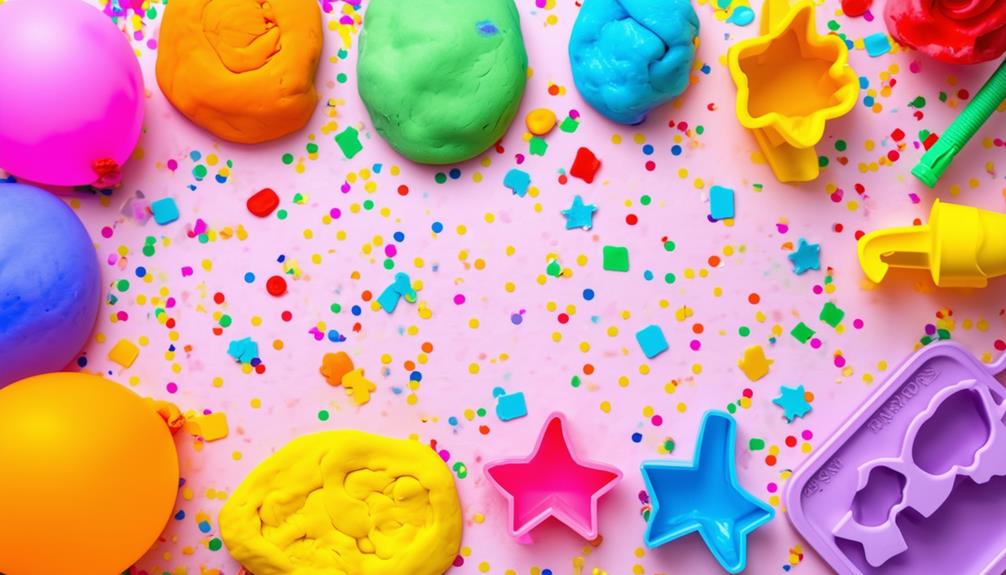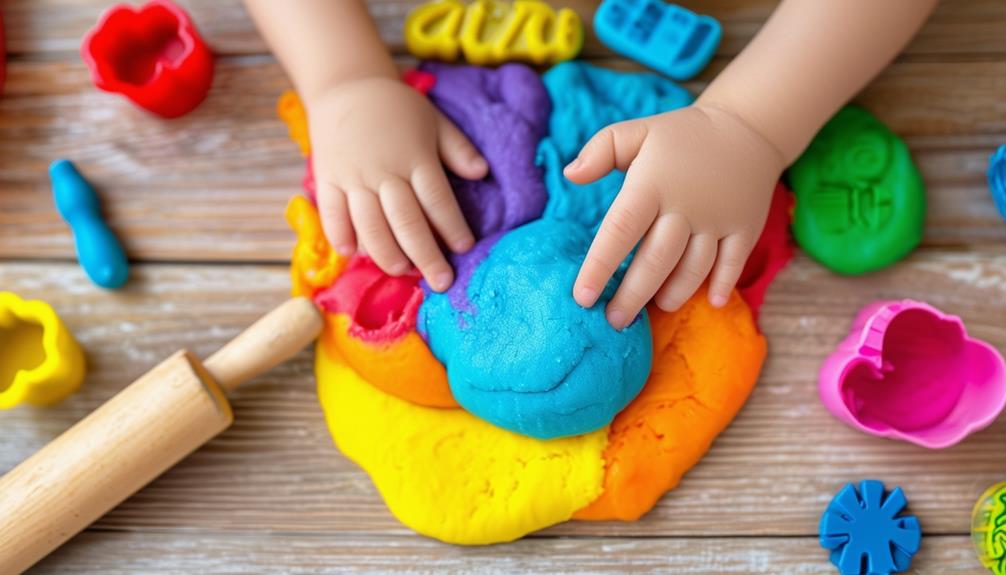How to Use Playdough for Teaching Shapes and Colors

Using playdough to teach shapes and colors can transform your classroom into an engaging learning environment. Combining vibrant dough with simple tools like cookie cutters and rolling pins captivates young minds while boosting fine motor skills. Imagine the excitement as they mix colors and mold shapes, unknowingly strengthening hand-eye coordination. How can you effectively incorporate this versatile tool into your teaching strategy to optimize both learning and fun?
Benefits of Fine Motor Skills
Playing with playdough significantly enhances fine motor skills in young children. Manipulating playdough involves hands-on activities that strengthen hand muscles and improve coordination. Tasks like rolling, pinching, and flattening the dough require precision and control, essential for developing fine motor skills.
Using cookie cutters to shape the playdough adds another layer to this developmental process. Children learn to press down firmly and wiggle the cutter to release the shape, refining their hand-eye coordination and dexterity. These skills are crucial for future tasks like writing, cutting with scissors, and handling small objects.
Moreover, playdough activities are not solely about building physical strength; they also encourage creativity and imagination. When children explore different shapes and colors through playdough, they engage both their hands and minds, enhancing cognitive and motor skills. Incorporating cookie cutters into these activities makes the learning process enjoyable and engaging, laying a strong foundation for academic and daily tasks requiring precision and control.
Materials Needed
To teach shapes and colors using play dough, you'll need a variety of play dough colors and essential tools. Ensure you have different shapes of cookie cutters, rolling pins, and plastic knives. Paper plates or trays can help keep the workspace organized and clean.
Essential Play Dough Tools
Having the right tools, such as multi-colored play dough and cookie cutters, enhances the experience of teaching shapes and colors, making it both enjoyable and effective. These tools not only enrich children's learning but also support the development of their problem-solving skills. By using a variety of play dough colors, children can learn to recognize and distinguish between different hues, establishing a solid foundation for color identification and creativity.
Rolling pins are essential for flattening the play dough, which simplifies cutting it into various shapes. Encouraging children to use rolling pins improves their fine motor skills and coordination. Child-safe plastic knives are excellent for cutting play dough into specific shapes, helping children enhance their accuracy and control.
Cookie cutters in various shapes, such as circles, squares, and triangles, provide a fun way to learn geometric shapes. Children can use these cutters to create different forms, reinforcing their shape recognition. Lastly, using paper plates or trays helps maintain a tidy workspace, ensuring play areas remain neat and organized. These basic materials make play dough activities both educational and enjoyable for children.
Variety of Play Dough
A wide variety of play dough colors, such as red, blue, and yellow, offers endless opportunities for teaching children about shapes and color combinations. By incorporating these vibrant colors, you can make learning more engaging and interactive. Watch as children become fascinated with color mixing, turning blue and yellow into green, and red and blue into purple. This hands-on learning approach not only helps them understand primary and secondary colors but also enriches their sensory play experience.
Different colored play dough can be used to distinguish shapes, stimulating creativity and making shape recognition more exciting. Imagine the joy on a child's face when they shape a bright yellow star or a red heart. Providing a variety of play dough colors helps develop color recognition skills while learning about different shapes, making the process both fun and educational.
Here's a quick guide to evoke some emotions and ideas:
| Play Dough Color | Activity Example |
|---|---|
| Red | Make a red heart |
| Blue | Shape a blue circle |
| Yellow | Create a yellow star |
Using a range of colors in play dough activities enriches visual stimulation and keeps children engaged, turning every play session into a delightful learning adventure.
Teaching Strategy
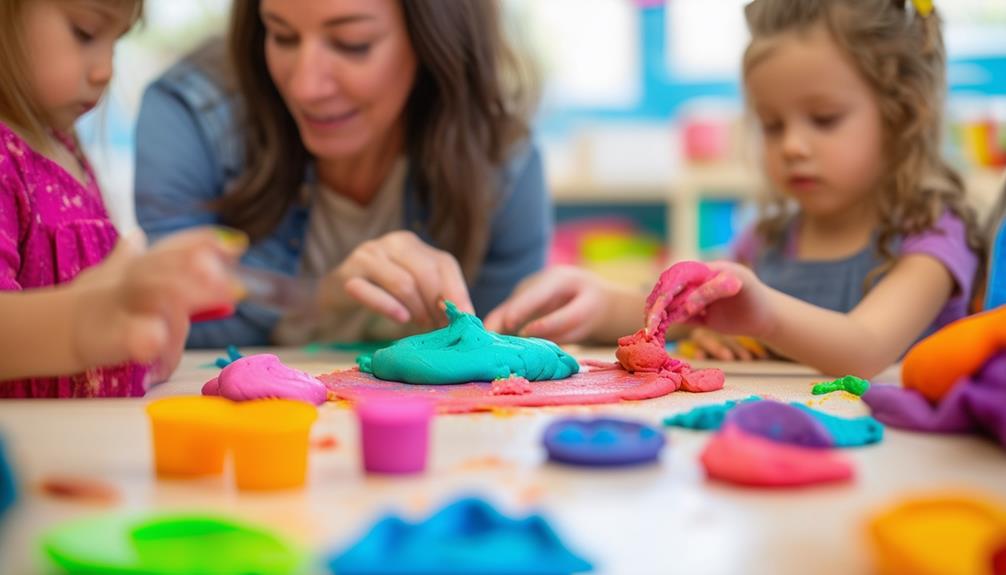
Incorporating play dough into your lessons can make learning shapes and colors both interactive and enjoyable for children. Start by demonstrating how to form basic shapes like squares, circles, triangles, and rectangles using play dough. These hands-on activities allow children to engage directly with the material, fostering a deeper understanding.
Utilize multi-sensory learning techniques by combining visual aids with the tactile experience of molding play dough. Show colorful charts or flashcards of shapes and colors alongside the play dough to reinforce recognition. By providing a visual reference, children can connect what they see with what they create, enhancing their learning process.
Encourage creative exploration by allowing children to mix different colors of play dough to discover new shades and hues. This teaches them about primary and secondary colors while stimulating their curiosity and imagination. As they experiment with different forms and colors, they develop fine motor skills and cognitive abilities. Incorporate play dough as a versatile teaching tool in your strategy to engage children and make learning about shapes and colors a fun, hands-on experience.
STEAM Components
Combining primary and secondary colors in playdough activities helps children grasp basic scientific principles. Using tools like cutters and rollers enhances creativity and technological skills. These activities teach shapes and colors while also improving problem-solving and fine motor abilities.
Integrating Primary and Secondary Colors
Mixing primary colors with playdough allows children to explore how red, blue, and yellow combine to create secondary colors like orange, green, and purple. These color-mixing activities engage kids in hands-on learning, helping them understand basic color theory. By experimenting with different playdough colors, children investigate color combinations in a creative and educational setting.
Encouraging kids to mix primary and secondary colors enhances their visual perception and helps them recognize relationships between different hues. This fun activity also lays the groundwork for more advanced STEAM concepts. By physically manipulating the playdough, children can see immediate results, fostering a deeper understanding of color interactions.
Incorporate activities where children blend small amounts of primary colors to observe the creation of secondary colors. This hands-on experience allows them to experiment and learn through trial and error. By integrating these activities into your teaching, you provide a tactile and visual method for children to grasp the fundamentals of color theory. This makes the abstract concept of color mixing tangible and memorable, setting a strong foundation for future learning.
Utilizing Tools for Creativity
Utilizing tools like rolling pins, knives, and cookie cutters in playdough activities ignites creativity while enhancing fine motor skills. These tools elevate simple play into a comprehensive, hands-on learning experience that integrates science, technology, engineering, art, and math (STEAM) elements. Through sensory exploration, children gain a deeper understanding of shapes, colors, and textures.
Encouraging children to use a variety of tools nurtures creative expression and problem-solving. For instance, when a child uses a knife to divide playdough into equal parts, they practice math skills and enhance critical thinking. Experimenting with different tools allows for unique manipulation of playdough, promoting an environment where critical thinking flourishes.
Moreover, using tools in playdough activities supports sensory exploration, fine motor development, and creativity. As children roll out playdough with a pin or cut shapes with a cookie cutter, they develop hands-on learning skills. These activities foster problem-solving and encourage kids to think creatively about achieving their desired outcomes. Overall, incorporating these tools enriches playdough activities, providing a well-rounded STEAM-based learning experience.
Learning About Shapes
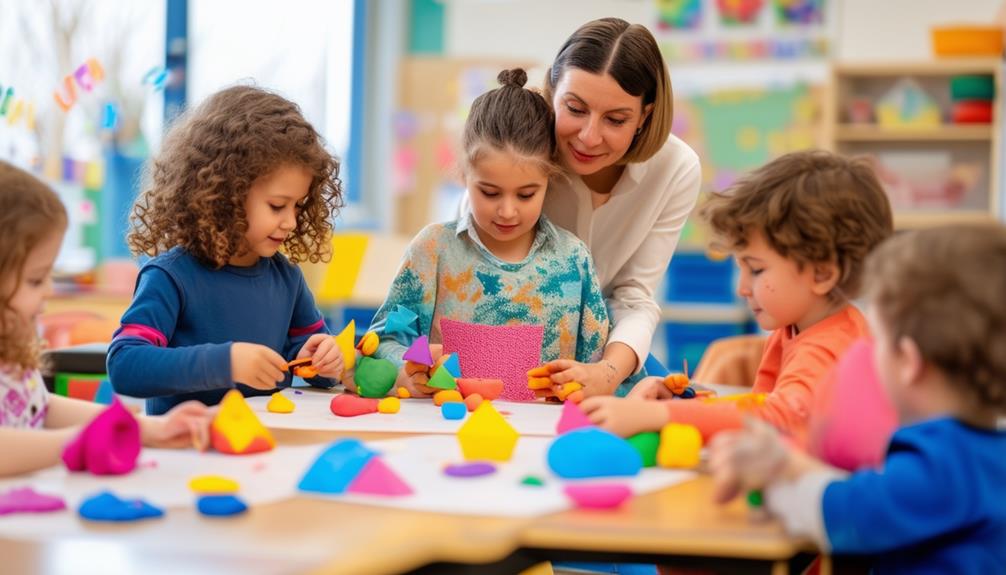
Teaching shapes with playdough makes learning enjoyable and helps children grasp fundamental geometry concepts. Shape recognition becomes engaging through hands-on activities. When kids mold playdough into circles, squares, and triangles, they're not just playing; they're internalizing the shapes they see in their surroundings. This interactive learning method ensures the knowledge sticks.
Creative learning peaks when children use playdough to explore shapes. Manipulating the dough develops spatial awareness, showing how different shapes fit together or combine to form new ones. This enhances their ability to visualize and understand spatial relationships, crucial for later mathematical learning.
Additionally, playdough activities foster problem-solving skills and artistic exploration. Kids think about how to transform a lump of dough into recognizable shapes, sharpening their critical thinking and creativity. They gain confidence as they create and identify different shapes, enhancing their artistic abilities and preparing them for more complex problem-solving tasks. Incorporating playdough into shape learning is a straightforward yet effective way to build a strong educational foundation.
Shape Playdough Mats
Shape playdough mats provide an engaging and effective way for children to explore geometric shapes while enhancing their fine motor skills. These printable templates encourage kids to fill, mold, and decorate shapes using playdough, making learning a tactile and enjoyable experience. This hands-on activity is particularly beneficial for tactile learners, as it allows them to feel and manipulate the dough.
Using shape playdough mats, children can improve their shape recognition skills in a playful manner. The mats feature clear outlines of various geometric shapes, prompting children to identify and recreate them. This repetitive practice helps reinforce their understanding of shapes while keeping them engaged.
Additionally, shape playdough mats can be customized to match different learning levels and interests. Whether introducing basic shapes like circles and squares or more complex ones like hexagons and trapezoids, the mats can be tailored to meet the child's needs. This adaptability makes them a versatile tool for educators and parents alike. Incorporating shape playdough mats into educational activities can transform abstract concepts into tangible and enjoyable learning experiences for young children.
Playdough for Preschoolers
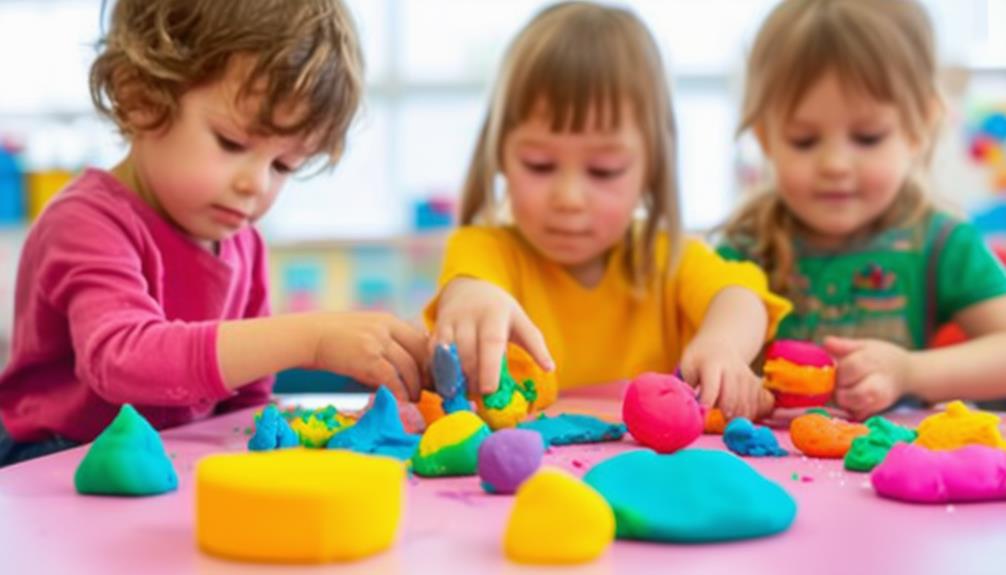
Considering the advantages of shape playdough mats, let's explore how playdough activities can captivate preschoolers while teaching them about shapes and colors. Playdough serves as an excellent medium for sensory exploration and hands-on learning. When children manipulate playdough, they engage in an educational activity that reinforces shape recognition. Forming squares, circles, triangles, and other shapes helps them understand the unique characteristics of each shape.
Color mixing with playdough is equally engaging. By combining different colors, children learn about primary and secondary colors, enhancing their grasp of color theory. This hands-on approach makes abstract concepts more tangible and easier to understand.
Playdough art also encourages creative expression. Children can create their own masterpieces, blending colors and shapes to form imaginative designs. This not only boosts their creativity but also improves fine motor skills and hand-eye coordination. Incorporating playdough into lessons on shapes and colors turns learning into a fun, interactive experience. It's a powerful tool that makes education enjoyable, helping young children better understand and retain these essential concepts.
Addition Facts Printable
For a fun and effective way to reinforce basic math skills, the addition facts printable is an excellent resource for young learners. This tool is perfect for practicing addition, helping kids master basic operations while having fun. You can use these printable resources for quick review sessions or integrate them into timed challenges to enhance math fluency.
Setting a timer for one-minute challenges with the printable can make learning addition facts engaging. These timed challenges not only make learning fun but also help children build confidence by demonstrating their growing proficiency in basic math operations.
Here's a simple example of how you can organize the addition facts printable:
| Addition Problem | Answer | Time Taken (Seconds) |
|---|---|---|
| 3 + 2 | 5 | |
| 7 + 4 | 11 | |
| 5 + 6 | 11 |
Using the printable regularly will ensure that kids become more confident and proficient in addition practice. The structure of the printable allows for consistent tracking of progress, making it easy to identify areas that need more attention. With regular use, young learners will find themselves mastering these basic operations with ease, setting a strong foundation for more advanced math skills.
User Engagement

Inviting users to share their comments, questions, and feedback about using playdough for teaching shapes and colors can significantly enhance the learning experience. When you share your thoughts on playdough activities, you contribute to building a community where parent involvement and creative expression flourish. Your insights can inspire others and introduce new methods for incorporating sensory play and interactive learning into daily routines.
Share your successes and challenges to encourage others. How did you use playdough to teach your child about shapes? Which colors captured their interest the most? These discussions can generate new ideas and techniques for hands-on engagement. Interactive learning becomes more effective when users exchange tips and resources.
Feel free to ask questions or seek advice in the comment section. Whether you're looking for new playdough recipes or ways to make learning shapes more enjoyable, this platform is here to support you. By fostering dialogue, we create a collaborative space where everyone benefits from a shared pool of knowledge.


